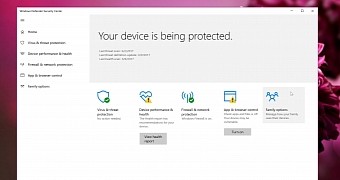Windows 10 has easily survived the WannaCry fiasco thanks to patches released by Microsoft in March this year, and Microsoft uses this opportunity to emphasize that it’s critical for users to upgrade their systems to the latest operating system because it includes mitigation systems and software to block the majority of threats these days.
Windows Defender is one particular solution that’s available for Windows 10 users, and in an analysis published today, the company explains that its built-in antivirus can automatically block “most ransomware and malware files at first sight.”
The software giant then goes on to explain that Windows Defender uses cloud power to verify suspicious files, with new and unknown threats blocked instantly thanks to cloud-based machine learning, deep neural networks, fuzzy matching, and other tech.
“Within seconds, Windows Defender AV cloud protection can determine if a new file is malicious or not. This information is stored in the cloud engine for future reference. Within minutes, this information is added to our machine learning classifiers and clustering, and is correlated with signals from the Microsoft Intelligent Security Graph. Windows Defender AV can then protect customers who might encounter the same or similar malicious file,” Microsoft explains.
Kaspersky: Nope.
Security company Kaspersky, which is also the maker of one of the most powerful antivirus solutions, says Windows Defender is not at all that good, turning to third-party antivirus test to show that it’s actually well behind competition in terms of threat detection, false positives, and performance.
Kaspersky has recently filed an antitrust complaint against Microsoft in Europe, claiming that the firm is using its dominant position to promote Windows Defender and to force Windows 10 users to stick with it.
“Maybe Microsoft is acting in the interests of users? Maybe its own solution isn’t only free but also an excellent antivirus so, like, why would anyone need another? Well, independent testing labs have found zero evidence of that,” Kaspersky said. “Microsoft’s own protection solution loses against our products on threat detection, on the number of false positives, and on performance.”
In the meantime, however, Microsoft remains committed to improving Windows Defender, and the recently-released Windows 10 Creators Update brings a major update in this regard, with the antivirus now called Windows Defender Security Center and grouping all the other security features on Windows 10, including parental controls and device health information.

 14 DAY TRIAL //
14 DAY TRIAL // 




